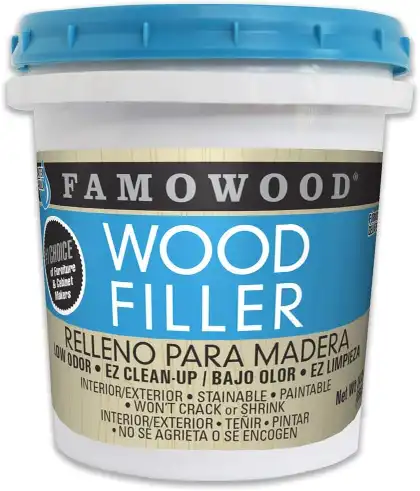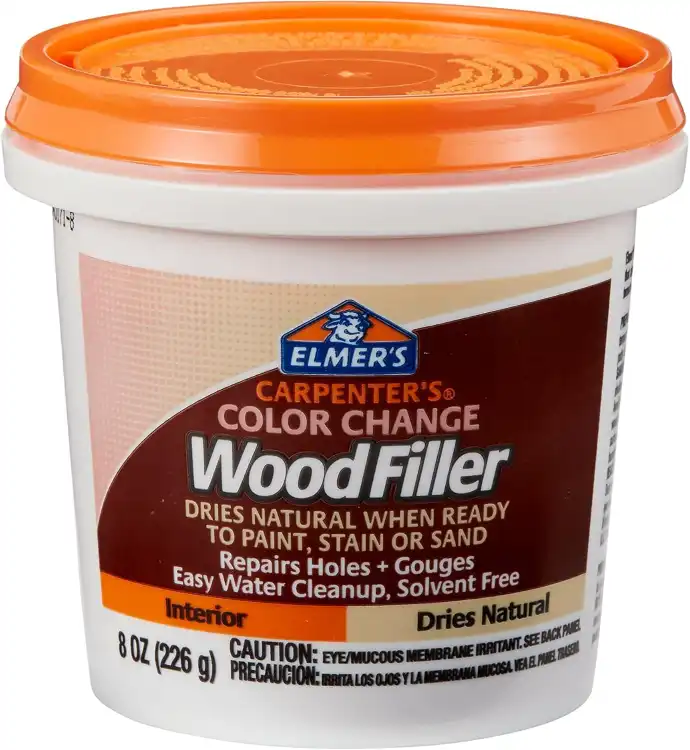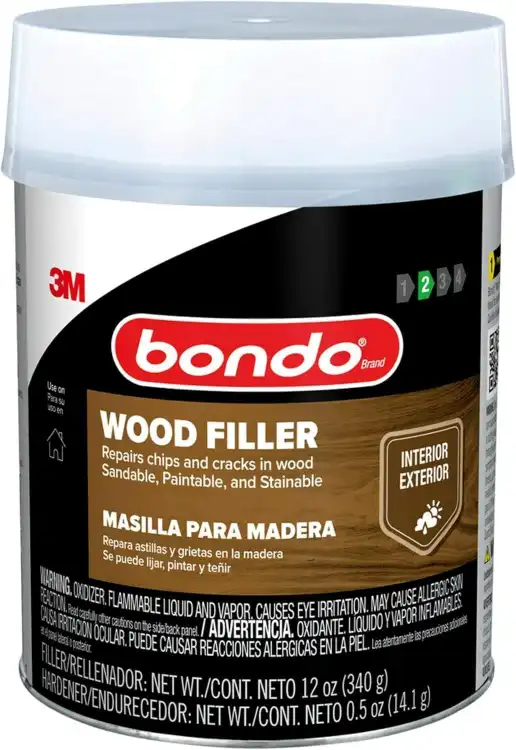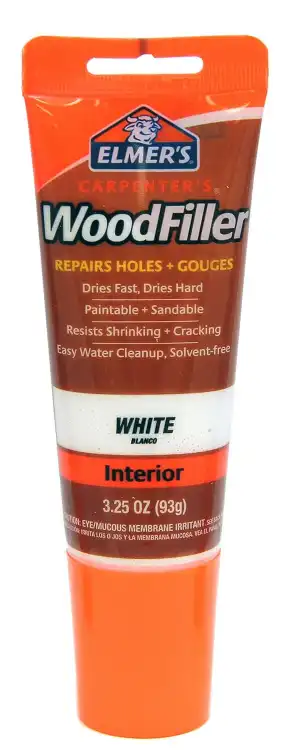Wood filler, often overlooked, plays a crucial role in wood repair and restoration. It is a substance that can fill in gaps, cracks, and holes in wood, restoring its original appearance and strength. This article aims to delve into the importance of wood filler in wood repair, its various types, and how to choose and apply the right one for your project.
Understanding the role and importance of wood filler is essential for anyone dealing with wood repair. Whether you’re a professional carpenter or a DIY enthusiast, the right knowledge about wood filler can make a significant difference in your work. This article will provide you with a comprehensive guide on everything you need to know about wood filler.
Let’s start by understanding what wood filler is, its different types, and its role in wood repair. This will lay the foundation for further discussion on its importance, how to choose the right one, and how to apply it correctly.
Our Top Wood Filler Picks

FamoWood 40022126 Latex Wood Filler – Pint, Natural
Check on AmazonKey Specs
- Size: 24 oz (1 pint)
- Drying Time: Dries in 15 minutes
- Features: Won’t crack or shrink
- Application: Sandable, drillable, and planeable
- Usage: Suitable for both interior and exterior use
FamoWood 40022126 Latex Wood Filler is a top-notch solution for repairing wood surfaces. What sets it apart is its fast drying time—just 15 minutes—without any cracking, shrinking, or crumbling. I love that it’s solvent-free, which makes cleanup a breeze with just water, and it has a low odor, perfect for indoor use. It takes stains and paints like real wood, making it ideal for both interior and exterior repairs. Whether sanding or drilling, it holds up beautifully.

Elmer’s E913 Carpenter’s Color Change Wood Filler
Check on AmazonKey Specs:
- Size: 8 oz
- Color Change: Goes on purple, dries natural
- Application: Sandable, stainable, and paintable
- Usage: For interior use only
- Cleanup: Easily cleaned with water
Elmer’s E913 Carpenter’s Color Change Wood Filler is a fantastic product for carpenters and woodworkers. Its patented color-change formula makes it easy to use—it starts purple and changes to a natural wood color when it’s ready to sand, stain, or paint. I appreciate that it’s sandable, stainable, and paintable, making it versatile for different projects. Cleanup is a breeze since it’s water-soluble, and the non-toxic formula makes it safe for indoor use. This wood filler ensures a seamless and professional finish every time.

12 oz Minwax 21600 High Performance Two-Part Wood Filler
Check on AmazonKey Specs:
- Size: 12 oz
- Usage: Repairs gouges, holes, and rotted wood
- Bonding: Adheres to wood, ceramics, concrete, metal, and fiberglass
- Function: Acts as both wood filler and adhesive
- Durability: Permanent repair for damaged wood
Minwax 21600 High Performance Two-Part Wood Filler is a game-changer for both wood repair and adhesive needs. It not only fills gouges and holes in damaged or rotted wood, but it also acts as a strong adhesive for securing screws and loose joints in furniture. What sets it apart is its ability to bond to a variety of materials—wood, ceramics, metal, concrete, and fiberglass—making it versatile. Its durability and strength make it an essential tool for both indoor and outdoor woodworking projects.

3M Bondo Wood Filler
Check on AmazonKey Specs:
- Size: 30 fl oz
- Curing Time: Sets in 15 minutes
- Durability: Resists shrinking and cracking
- Application: For interior and exterior wood surfaces
- Paint/Stain: Paintable and stainable for seamless finishes
3M Bondo Wood Filler is an essential tool for anyone needing fast and reliable wood repairs. Its two-part formula sets in just 15 minutes, allowing you to sand, paint, or stain quickly—ideal for those on a tight schedule. The filler forms a strong, permanent bond that resists shrinking and cracking, ensuring durable, long-lasting repairs. It’s versatile enough for all types of wood surfaces and can be shaped or drilled to suit various projects, making it a top choice for professionals and DIYers alike.

Elmer’s E855 Carpenter’s Wood Filler, 3.25-Ounce Tube, White
Check on AmazonKey Specs:
- Size: 3.25 oz
- Color: White
- Form: Cream
- Sanding: Sands easily for a smooth finish
- Cleanup: Easy water cleanup
Elmer’s E855 Carpenter’s Wood Filler is a must-have for any wood repair project. Its smooth, creamy consistency makes it easy to apply, and it dries to a flawless finish that can be easily sanded. This filler resists shrinking and cracking, ensuring your repairs hold up over time. Plus, it’s paintable, allowing it to blend seamlessly with the surrounding wood. For anyone who needs a reliable, quick-drying filler with easy cleanup, this product delivers impressive results.
Understanding Wood Filler
Wood filler, also known as wood putty, is a substance used to fill imperfections in wood like holes, scratches, and gouges. It is made from wood dust mixed with a binder, which could be water, solvent, or epoxy. Once applied, it hardens to mimic the properties of real wood and can be sanded, painted, or stained to match the surrounding wood.
There are different types of wood fillers available in the market, each with its unique properties and uses. The most common types include water-based, solvent-based, and epoxy-based wood fillers. Each type has its advantages and disadvantages, which we will discuss later in this article.
The role of wood filler in wood repair is multifaceted. It not only helps in filling gaps and holes but also strengthens the wood, enhances its aesthetics, and prevents further damage. It is an indispensable tool in the arsenal of any woodworker.
Importance of Wood Filler in Wood Repair
Wood filler plays a crucial role in preserving the integrity of wood. Over time, wood can develop cracks, holes, and other imperfections due to various factors like weather, insects, and wear and tear. These imperfections can compromise the strength and durability of the wood. Wood filler can fill these imperfections, restoring the wood’s strength and prolonging its life.
Besides preserving the integrity of wood, wood filler also enhances its aesthetics. It can fill in imperfections, resulting in a smooth, uniform surface. Once sanded and painted, the repaired area blends seamlessly with the surrounding wood, making the repair virtually invisible.
Moreover, wood filler can prevent further wood damage. By filling in cracks and holes, it prevents water and insects from penetrating the wood, which can cause further damage. It acts as a protective barrier, safeguarding the wood from future damage.
Factors to Consider When Buying Wood Filler
When buying wood filler, the type of wood you’re working with is an important consideration. Different types of wood have different characteristics and may require different types of wood fillers. For example, hardwoods like oak and mahogany are dense and may require a stronger wood filler like epoxy-based filler. On the other hand, softwoods like pine and cedar are less dense and can be repaired with any type of wood filler.
The size of the wood damage is another important factor to consider. For small repairs like filling nail holes or minor scratches, a lightweight, easy-to-sand filler like water-based filler would be suitable. For larger repairs like filling large holes or cracks, a stronger, more durable filler like epoxy-based filler would be more appropriate.
Whether the wood is for indoor or outdoor use is also a crucial consideration. For outdoor wood, a weather-resistant wood filler like epoxy-based or solvent-based filler would be ideal. For indoor wood, any type of wood filler would suffice as it is not exposed to harsh weather conditions.
Different Types of Wood Fillers
Water-based wood fillers are made from wood dust and water. They are easy to apply, dry quickly, and can be cleaned up with water. They are also easy to sand and can be painted or stained to match the surrounding wood. However, they are not as durable as other types of fillers and may not be suitable for large repairs or outdoor use.
Epoxy-based wood fillers are made from two components: a resin and a hardener. When mixed together, they form a strong, durable filler that can fill large holes and cracks. They are weather-resistant and can be used for both indoor and outdoor wood. However, they are harder to sand and may require more effort to smooth out.
Solvent-based wood fillers are made from wood dust and a solvent. They are durable and can be used for both indoor and outdoor wood. They are also easy to sand and can be painted or stained to match the surrounding wood. However, they have a strong smell and require proper ventilation during application.
Pros and Cons of Different Types of Wood Fillers
Water-based wood fillers are easy to apply, dry quickly, and can be cleaned up with water. They are also easy to sand and can be painted or stained to match the surrounding wood. However, they are not as durable as other types of fillers and may not be suitable for large repairs or outdoor use.
Epoxy-based wood fillers are strong and durable, making them suitable for large repairs. They are also weather-resistant, making them suitable for outdoor use. However, they are harder to sand and may require more effort to smooth out. They also have a longer drying time compared to other types of fillers.
Solvent-based wood fillers are durable and can be used for both indoor and outdoor wood. They are also easy to sand and can be painted or stained to match the surrounding wood. However, they have a strong smell and require proper ventilation during application. They also have a longer drying time compared to water-based fillers.
How to Choose the Right Wood Filler for Your Project
Choosing the right wood filler for your project requires a careful assessment of the nature of the wood damage. For small repairs like filling nail holes or minor scratches, a lightweight, easy-to-sand filler like water-based filler would be suitable. For larger repairs like filling large holes or cracks, a stronger, more durable filler like epoxy-based filler would be more appropriate.
The type of wood is also an important consideration. Different types of wood have different characteristics and may require different types of wood fillers. For example, hardwoods like oak and mahogany are dense and may require a stronger wood filler like epoxy-based filler. On the other hand, softwoods like pine and cedar are less dense and can be repaired with any type of wood filler.
The location of the wood is another crucial factor. For outdoor wood, a weather-resistant wood filler like epoxy-based or solvent-based filler would be ideal. For indoor wood, any type of wood filler would suffice as it is not exposed to harsh weather conditions.
Application of Wood Filler
The first step in applying wood filler is to prepare the wood surface. This involves cleaning the area to be repaired and removing any loose wood or debris. The area should be dry and free of dust, dirt, and grease. If the wood is rotten, it should be removed and replaced before applying the wood filler.
The application process involves applying the wood filler into the hole or crack using a putty knife. The filler should be applied in layers if the hole or crack is deep. Each layer should be allowed to dry before applying the next. Once the filler has dried, it can be sanded smooth and painted or stained to match the surrounding wood.
The drying and sanding process is crucial for a smooth, seamless repair. The filler should be allowed to dry completely before sanding. This could take anywhere from a few hours to a few days, depending on the type of filler and the size of the repair. Once dry, the filler can be sanded smooth using fine-grit sandpaper. The repaired area can then be painted or stained to match the surrounding wood.
Safety Measures When Using Wood Fillers
When using wood fillers, proper ventilation is crucial. Some types of wood fillers, especially solvent-based fillers, have a strong smell and can release harmful fumes. Therefore, it’s important to work in a well-ventilated area or wear a respirator if necessary.
Protective gear like gloves and safety glasses should also be worn to protect against potential skin and eye irritation. Even though wood fillers are generally safe to use, it’s always a good idea to take precautions to protect yourself.
Wood fillers should be stored safely out of reach of children and pets. They should be kept in a cool, dry place and their lids should be tightly sealed to prevent them from drying out. It’s also important to dispose of any leftover filler properly, according to local regulations.
Top Wood Filler Brands in the Market
There are many wood filler brands in the market, each with its unique offerings. Some of the top brands include Elmer’s, Minwax, and DAP. These brands offer a wide range of wood fillers suitable for different types of wood and repairs.
Elmer’s is known for its easy-to-use, water-based wood fillers that are ideal for small repairs. They dry quickly and can be easily sanded, painted, or stained. Minwax offers a range of wood fillers, including water-based, solvent-based, and epoxy-based fillers. Their fillers are durable and can be used for both indoor and outdoor wood. DAP offers a range of solvent-based fillers that are durable and weather-resistant, making them suitable for outdoor use.
When comparing these brands, it’s important to consider factors like the type of filler, its durability, drying time, ease of application, and price. This will help you choose the right filler for your project.
Case Study: Successful Wood Repair Using Wood Filler
Let’s take a look at a real-life example of a successful wood repair using wood filler. The project involved repairing a large hole in a wooden door. The hole was caused by a doorknob that had been forcefully pushed into the door.
The repair process involved cleaning the area around the hole and removing any loose wood. Then, an epoxy-based wood filler was mixed and applied into the hole using a putty knife. The filler was applied in layers, with each layer allowed to dry before applying the next. Once the hole was completely filled and the filler had dried, it was sanded smooth and painted to match the surrounding wood.
The outcome of the project was a seamless repair that restored the door’s strength and aesthetics. The repaired area blended perfectly with the surrounding wood, making the repair virtually invisible. This case study demonstrates the effectiveness of wood filler in repairing wood damage and restoring wood’s original appearance and strength.
Common Mistakes to Avoid When Using Wood Fillers
One common mistake when using wood fillers is incorrect application. This could be applying too much filler, not applying it in layers for deep holes or cracks, or not allowing each layer to dry before applying the next. These mistakes can result in a poor-quality repair that may not last.
Another common mistake is using the wrong type of filler. As discussed earlier, different types of wood and repairs require different types of fillers. Using the wrong type of filler can result in a repair that is not durable or does not match the surrounding wood.
Inadequate preparation of the wood surface is another common mistake. The area to be repaired should be clean and free of dust, dirt, and grease. Any loose wood or debris should be removed. If the wood is rotten, it should be removed and replaced before applying the filler. Failing to properly prepare the wood surface can result in a repair that does not adhere properly and may not last.
Maintenance Tips for Wood Filler Repairs
Regular inspection of the repaired area is crucial for maintaining the repair. This involves checking for any signs of damage like cracks or peeling paint. If any damage is spotted, it should be repaired immediately to prevent further damage.
Proper cleaning of the repaired area is also important. This involves cleaning the area with a damp cloth to remove dust and dirt. Any spills should be wiped up immediately to prevent staining. It’s also a good idea to periodically clean the area with a wood cleaner to maintain its appearance.
Timely repair of any damage is another important maintenance tip. If the filler starts to crack or peel, it should be repaired immediately. This involves removing the damaged filler, cleaning the area, and applying new filler. This will ensure that the repair lasts and the wood remains protected.
Conclusion
Wood filler is an essential tool in wood repair. It not only fills in imperfections in wood but also strengthens the wood, enhances its aesthetics, and prevents further damage. Understanding the different types of wood fillers and how to choose and apply the right one for your project is crucial for a successful repair.
Whether you’re a professional carpenter or a DIY enthusiast, the right knowledge about wood filler can make a significant difference in your work. So, the next time you’re faced with a wood repair, remember the importance of wood filler and use it wisely.
Remember, the key to a successful wood repair is not just choosing the right wood filler, but also applying it correctly and maintaining the repair. So, take the time to learn about wood filler and practice your skills. With the right knowledge and practice, you can master the art of wood repair.
FAQ
What is wood filler?
Wood filler, also known as wood putty, is a substance used to fill imperfections in wood like holes, scratches, and gouges. It is made from wood dust mixed with a binder, which could be water, solvent, or epoxy.
What are the different types of wood fillers?
The most common types of wood fillers include water-based, solvent-based, and epoxy-based wood fillers. Each type has its advantages and disadvantages, which should be considered when choosing a filler for your project.
How do I choose the right wood filler for my project?
Choosing the right wood filler for your project requires a careful assessment of the nature of the wood damage, the type of wood, and the location of the wood. For small repairs, a lightweight, easy-to-sand filler like water-based filler would be suitable. For larger repairs or outdoor wood, a stronger, more durable filler like epoxy-based filler would be more appropriate.
